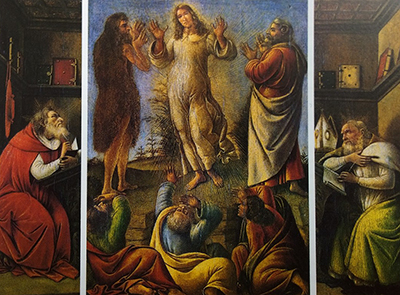Sandro Botticelli's depiction of saints continued with this small fresco from 1500 which is now to be found at the Palazzo Pallavicini-Rospigliosi in Rome
The Transfiguration, St Jerome and St Augustine was a tempera on panel measuring 28cm x 36 cm which is believed to have been executed, atleast in part, by Botticelli's workshop after significant design and guidance from the master himself.
The use of workshop assistants was common for many famous names from the Renaissance and should not be considered a reason to downplay the quality or significance of this artwork. Put simply, without this method of production, Michelangelo's work in the Sistine Chapel may never have come about.
There are three elements to this overall painting, as touched upon in its title. It was rare for Botticelli to put together a triptych, though this method of putting together multiple artworks was frequent within the Renaissance era. The three panels in question were titled St Jerome in his Study (left panel), Transfiguration (central panel) and St Augustine in his Study (right panel). The overall triptych is sometimes referred to simply as Transfiguration, focusing purely on the central panel.
Saint Augustine continues in Botticelli's career with St Augustine and St Augustine in his Cell. Raphael famously used him in Disputation of the Holy Sacrement and he also appeared in various Michelangelo drawings.
This artwork was first attributed to Sandro Botticelli in 1911 and it is known to have been at the Palazzo Pallavicini-Rospigliosi in Rome since the mid-19th century, but little more is known from before that point. It is even just in the past 20 or 30 years that attribution has been confidently claimed, with some art historians previously disputing the work as necessarily Botticelli's.
The artist's use of colour in Mystical Nativity shows clear similarities to Transfiguration, St Jerome, St Augustine and serves as evidence of his own touch on this painting.




